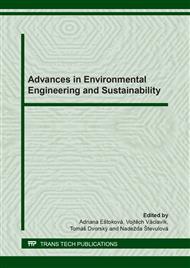[1]
C. Ainza, J. Trevors, M. Saier, Environmental Mercury rising, Wat. Air. Soil. Poll., 205 (2010) 47- 48.
DOI: 10.1007/s11270-007-9523-9
Google Scholar
[2]
A.V. Ajaykumar, A.D. Nalf, N. Hilal, Study of Various Parameters in the Biosorption of Heavy Metals on Sludge, Worl. App. Sci. J., 5 (2009) 32-40.
Google Scholar
[3]
M. Athar, S.B. Vohora, Heavy Metals and Environmental, New Age International (P) Limited Publishers, 4835/24, Ansari Road, Daryaganji, New Delhi 2006, 110002.
Google Scholar
[4]
E. Atikpo, M.O. Ezugwu, Preferential Removal of Lead, Cadmium and Zinc from Contaminated Agricultural soil by Bacillus subtilis, J. Nig. Assoc. Math. Phys. 41 (2017) 339-346.
Google Scholar
[5]
E. Atikpo, A. Michael, Performance Evaluation of Six Microorganisms Ultilized for the Treatment of Lead Contaminated Agricultural Soil, J. Appl. Sci. Envi.. Manag. 22(7) (2018) 1105-1109.
DOI: 10.4314/jasem.v22i7.18
Google Scholar
[6]
E. Atikpo, Spatial Distribution and Attenuation of Heavy Metals Pollution in AmaonyeIshiagu Forest Soils, A PhD Thesis Submitted to the Department of Civil Engineering, University of Benin, Benin City, Nigeria, (2016).
Google Scholar
[7]
E. Atikpo, B.U. Anyata, Variation of Factors for Metals Removal: A Guide to Factors Selection for Bioremediation of Heavy Metals Polluted Soils in Amaonye-Ishiagu of Ebonyi State in Nigeria. J. Civ. Envi. Systems Eng. 13 (2015) 172-181.
Google Scholar
[8]
R.K. Badawy, A.M.A. El-Gawad, H.E. Osman, (2013). Health Risks Assessment of Heavy Metals and Microbial Contamination in Water, Soil and Agricultural Foodstuff from Waste Water Irrigation at Sahl El-Hessania area, Egypt, J. App. Sci. Res., 9 (4) (2013) 3091-3107.
Google Scholar
[9]
M.A.O. Badmus, T.O.K. Audu, B.U. Anyata, Removal of Lead Ion from Industrial Wastewaters by Activated Carbon Prepared from Periwinkle Shells (Typanotonusfuscatus), Turk. J. Envi. Engi. Sci. 31 (2007) 251-263.
DOI: 10.1007/s11814-007-5049-5
Google Scholar
[10]
E.J. Baron, L.R. Peterson, S.M. Finegold, Bailey and Scotts Diagnostic Microbiology, 9th Edition. Mosby, Baltimore, (1994).
Google Scholar
[11]
A. Begum, M. Ramaiah, O. Harikrishna, K. Irfanulla, K. Veena, Analysis of Heavy Metal Concentrations in Soil and Litchen from Various Localities of Hosur Road, J. Chem. 6(1) (2009) 13-22.
DOI: 10.1155/2009/943695
Google Scholar
[12]
H. Chen, A. Wang, Kinetic and Isothermal Studies of Lead Ion Adsorption onto Palygorskite Clay, J. Coll. Int. Sci., 307 (2007) 309-316.
DOI: 10.1016/j.jcis.2006.10.054
Google Scholar
[13]
M. Chessebrough, Disrict Laboratory Pactice in Troppical Countries, Part 2, Cambridge low Price Edition, Cambridge University Press, London, (2000).
Google Scholar
[14]
S.H. Chien, W.R. Clayton, Application of Elovich Equation to the Kinetics of Phosphate Release and Sorption on Soil, J. Soil Sci. 44 (1980) 265-268.
DOI: 10.2136/sssaj1980.03615995004400020013x
Google Scholar
[15]
S.T. Cowan, Cowan and Steels Manual for the Identification of Medical Bacteria, Cambridge University Press, London, (1993).
Google Scholar
[16]
S.T. Cowan, R. Steel, Manual for the Identification of Medical Bacteria, Cambridge University Press, London, (1990).
Google Scholar
[17]
S.M. Daboor, Application of Bacterial Biomass as A Potential Heavy Metal Bio-Removal Agent, Afr. J. Micr. Res., 8(22) (2014) 2229-2237.
DOI: 10.5897/ajmr2014.6837
Google Scholar
[18]
H.N. Ezeh, E. Chukwu, Small Scale Mining and Heavy Metals Pollution of Agricultural Soils: The Case of Ishiagu Mining District, South Eastern Nigeria, J. Geo. Min. Res. 3(4) (2011) 87-104.
Google Scholar
[19]
R.V. Galiulin, V.N. Bashkin, R.A. Galiulina, R. Kucharski, (2002). Airborne Soil Contamination by Heavy Metals in Russia and Poland, and its Remediation, Land Cont. Recl. 10(3) (2002) 179-187.
DOI: 10.2462/09670513.607
Google Scholar
[20]
Y.S. Ho, D.A. John Wase, C.F. Forster, Study of the Sorption of Divalent Metal Ions onto Peat, Adsor. Sci. Tech. 18 (2000) 639-650.
DOI: 10.1260/0263617001493693
Google Scholar
[21]
J.C. Holt, The Shorter Bergeys Manual of Determinative Bacteriology, Eight Edition, Williams and Willkins Company, Baltimore, (1994).
Google Scholar
[22]
C. Lin, H. Lin, Remediation of soil contaminated with the heavy metal (Cd2+), J. Hazar. Mat. 122(1-2) (2005) 7-15.
Google Scholar
[23]
G. Mckay, V.J. Poots, Kinrtics and Diffussion Processes in Colour Removal from Effluent Using Wood as an Adsorbent, J. Che. Tech. Biotech., 30 (1980) 279-292.
DOI: 10.1002/jctb.503300134
Google Scholar
[24]
S. Murthy, G. Bali, S.K. Sarangi (2012).Biosorption of Lead by Bacillus Cereus Isolated from Industrial Effluents, Brit. Biot. J. 2(2) (2012) 73-84.
Google Scholar
[25]
S. Nanda, J. Abraham, Remediation of Heavy Metal Contaminated Soil, Afr. J. Biotech. 12(2) (2013) 3099-3109.
Google Scholar
[26]
V.O. Nwaugo, R.A. Onyeagba, E.I. Akubugwo, S. Ugbogu, (2008). Soil Bacterial Flora and Enzymatic Activities in Zinc and Lead Contaminated Soil, Biok. 20(2) (2008) 77-84.
Google Scholar
[27]
G.O. Onyedika, G.U. Nwosu, Lead, Zinc and Cadmium in Root Crops from Mineralized Galena-Sphalerite Mining Areas and Environment, Pak. J. Nutr., 7(3) (2008) 418-420.
DOI: 10.3923/pjn.2008.418.420
Google Scholar
[28]
H.I. Owamah, Biosorptive removal of Pb (II) and Cu (II) from wastewater using activated carbon from cassava peels, J. Mat. Cycl. Wast. Manag. 16(2) (2014) 347-358.
DOI: 10.1007/s10163-013-0192-z
Google Scholar
[29]
A.K. Pendias, H. Pendias, Elements of Group VIII. In: Trace Elements in Soils and Plants. Boca Raton: CRC Press, (1992) 271-276.
DOI: 10.1017/s0014479711000743
Google Scholar
[30]
D.P. Samarth, C.J. Chandekar, Bhadekar, Biosorption of heavy Metals from Aqueous Solution using Bacillus Licheniformis, Int. J. Pure Appl. Sci. Tech., 10(2) (2012) 12-19.
Google Scholar
[31]
K.Vaxevanidou, N. Papassiopi, I. Paspaliaris, (2008). Removal of Heavy Metals ans Arsenic from Contaminated Soil using Bioremediation and Chelant Extraction Techniques, Chemos. 70 (2008) 1329-1337.
DOI: 10.1016/j.chemosphere.2007.10.025
Google Scholar
[32]
M. Vidali, Bioremediaton, an Overview, Pure Apl. Chem., 73 (2001) 1163-1172.
Google Scholar
[33]
P.M. White, D.C. Wolf, G.J. Thomas, C.M. Reynolds, Phytoremediation of Alkylated Polycyclic Aromatic Hydrocarbon in an Oil-Contaminated Soil, Wat. Air Soil Poll., 169 (2006) 207-220.
DOI: 10.1007/s11270-006-2194-0
Google Scholar
[34]
World Health Organization, Health Guidelines for the Use of Waste Water in Agriculture and Aquaculture, Report of a Scientific Group Meeting, Technical Report Series, No. 778, World Health Organisation, Geneva, (2001).
Google Scholar


